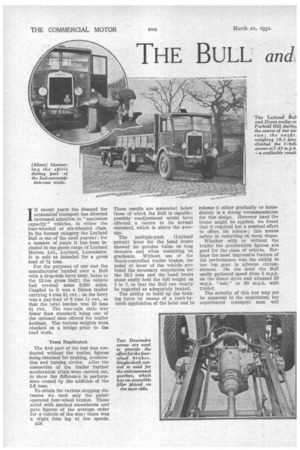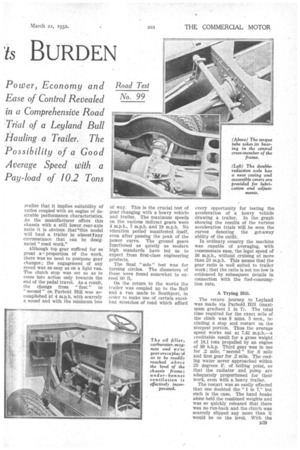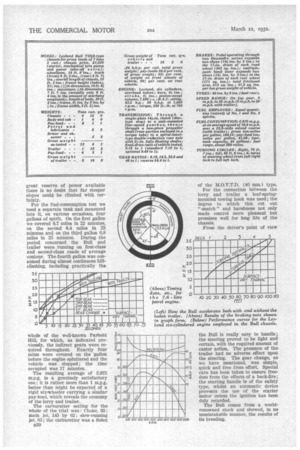THE BULL and is BURDEN I N recent years the demand
Page 46

Page 47

Page 48

If you've noticed an error in this article please click here to report it so we can fix it.
for economical transport has directed increased attention to "maximum capacity" vehicles, in either the four-wheeled or six-wheeled class. In the former category the Leyland Bull is one of the most popular ; for a number of years it has been included in the goods range of Leyland Motors, Ltd., Leyland, Lancashire. It is sold as intended for a gross load of 71 tons.
For the purposes of our test the manufacturer handed over a Bull with a drop-side lorry body, laden to the 12-ton gross limit; the vehicle had covered some 8,000 miles. Coupled to it was a Dyson trailer carrying 4 tons 31 cwt.; on the lorry was a pay-load of 6 tons 11 cwt., so that the total burden was 10 tons 41 cwt. The rear-axle ratio was lower than standard, being one of the optional ones offered for trailer haulage. The various weights were checked on a bridge prior to the road work.
Taste Duplicated.
The first part of the test was conducted without the trailer, figures being obtained for braking, acceleration and turning circles. After the connection of the trailer further acceleration trials were carried out, to show the difference in performance caused by the addition of the 5.8 tons.
To obtain the various stopping distances we used only the pedaloperated four-wheel brakes. These acted with marked smoothness and gave figures of the average order for a vehicle of the size; there was a slight time lag at low speeds.
n28 These results are somewhat below those of which the Bull is capable; possibly readjustment would have effected a return to its normal standard, which is above the average.
The multiple-push (Leyland patent) lever for the hand brake showed its genuine value on long descents and when restarting on gradients. Without use of the Neate-controlled trailer brakes, the pedal or lever of the vehicle provided the necessary retardation for the 18.1 tons and the hand brake alone easily held the full weight on 1 in 7, so that the Bull can clearly be regarded as adequately braked.
The ability to build up the braking force by means of a tooth-bytooth application of the lever and to release it either gradually or immediately is a strong recommendation for this design. However hard the brake might be applied, we found that it required but a nominal effort to effect its release ; this meanz safety in restarting on steep slopes.
Whether with or without the trailer the acceleration figures are good for the class of vehicle. Perhaps the most impressive feature of the performance was the ability to use top gear in adverse circumstances. On the level the Bull easily gathered speed from 5 m.p.h. on the direct drive and attained 35 m.p.h. " solo " or 30 m.p.h. with trailer.
The severity of this test may not be apparent to the uninitiated, but experienced transport men will realize that it implies suitability of ratios coupled with an engine of desirable performance characteristics. As the manufacturer offers this chassis with a still lower ,rear-axle ratio it is obvious thatIthis model will haul a trailer in almost ranY circumstance that can be designated "road work."
Although top gear sufficed for so great a proportion of the work, there was no need to postpone gear changes; the engagement of any speed was as easy as on a light van. The clutch stop was set so as to come into action only towards the end of the pedal travel. As a result, the change from " first " to " second " on. Parbohl Hill was accomplished at 4 m.p.h. with scarcely a sound and with the minimum loss of way. This is the crucial test of gear changing with a heavy vehicle and trailer. The maximum spee4 on the various indirect gears were 4 m.p.h., 7 m.p.h. and 18 m.p.h. No vibration period manifested itself, even after passing the peak of the power curve. The ground gears functioned as quietly as modern high standards have led us to expect from first-class engineering products.
The final " solo " test was for turning circles. The diameters of these were found Somewhat to exceed GO ft.
On the return to the works the trailer was coupled up to the Bull and a run made to Southport, in order to make use of certain excellent stretches of road which afford
every opportunity for testing the acceleration of a heavy vehicle drawing a trailer. In the graph showing the results of the various acceleration trials will he seen the curves denoting the get-away ability of the outfit.
In ordinary country the machine was capable" of averaging, with consummate ease, -the legal speed of 16 m.p.h., without cruising at more than 20 m.p.h. This means that the gear ratio is well suited to trailer work ; that the ratio is not too low is evidenced by subsequent details in connection with the fuel-consumption rate, A Trying Hill.
The return journey to Leyland was made via Parbold, Hill (maximum gradient 1 in 7). The total time required for the exact mile of the climb was 8 mins. 5 secs., including a stop and restart on the Steepest portion. Thus the average speed works out at 7.42 m.p.h.—a creditable result for a gross weight of 18.1 tons propelled by an engine of 89 b.h.p. Third gear was in use for .2 mile, " second " for .6 mile and first gear for .2 mile. The cooling water never approached within 20 degrees F. of boiling point, so that the radiator and pump are adequately proportioned for their work, even with a heavy trailer.
The restart was so easily effected that one doubted the "1 in 7," but such is the case. The hand brake alone held the combined weights and was so quickly released that there was no run-back and the clutch was scarcely slipped any more than it would he on the level. With the
great reserve of power available there is no doubt that far steeper slopes could be climbed with certainty.
For the fuel-consumption test we used a separate tank and measured into it, on various occasions, four gallons of spirit. On the first gallon we covered 6.7 miles in 22 minutes, on the second 6.4 miles in 23 minutes and on the third gallon 6.8 miles in 25 minutes. During the period concerned the Bull and trailer were running on first-class and second-class roads of average contour. The fourth gallon was consumed during almost continuous hillclimbing, including practically the whole of the well-known Parbold Hill, for which, as indicated previously, the indirect gears were required throughout. Exactly four miles were covered on the gallon before the engine spluttered and the vehicle was stopped; the time occupied was 17 minutes.
The resulting average of 5.975 m.p.g. is a genuinely satisfactory one; it is rather more than 1 m.p.g. better than might be expected of a rigid six-wheeler carrying a similar pay-load, which reveals the economy of the lorry and trailer.
The carburetter setting for the whole of the trial was: Choke, 33; main jet, 145 by 62; slow-running jet, 65; the carburetter was a Solex n31) of the M.O.V.T.D. (40 mm.) type.
For the connection between the lorry and trailer a leaf-springmounted towing hook was used; the degree to which this cut out " snatch" and harshness not only made control more pleasant but promises well for long life of the chassis.
From the driver's point of view the Bull is really easy to handle; the steering proved to be light and certain, with the required amount of castor action. The presence of the trailer had no adverse effect upon the steering. The gear change, as we have mentioned, was simple, quick and free from effort. Special care has been taken to ensure freedom from the effects of a back-fire; the starting handle is of the safety type, whilst an automatic device prevents the use of the starter motor unless the ignition has been duly retarded.
The Bull comes from a worldrenowned stock and showed, in no unmistakable manner, the results of its breeding.




































































































